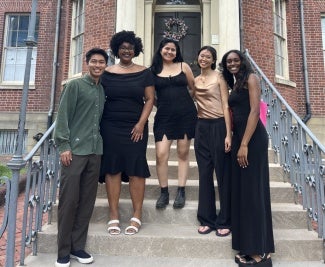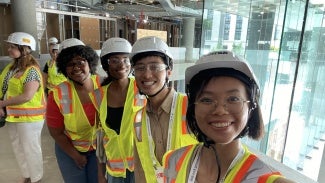
"I had never been in a space like that": The impact of the Diversity Advancement Scholarship
Architecture student Rachel Wiggins on how the Architects Foundation's support is helping her to realize her dream.
Rachel Wiggins is in her fourth year of a five-year architecture program at the University of Southern California. In high school, she applied for the Architects Foundation Diversity Advancement Scholarship and was accepted. “I really aligned with what they were looking for in candidates, and also their mission,” she says.
Since 1970, the Diversity Advancement Scholarship has “been awarded to help build a pipeline of architects so that the profession better reflects the diverse communities they serve,” according to the Architects Foundation. Scholarship recipients are awarded up to $20,000 and connected to a network of alumni, mentors and scholars. We chatted with Wiggins about her goal of becoming one of a small minority of Black licensed women architects.
What initially got you interested in architecture? What made you want to pursue this career path?
It’s kind of embarrassing, but I play this video game called Minecraft. [laughs] In Minecraft, I would make entire cities, from designing the streets to zoning the city. I felt like I was really accustomed to urban planning and all of those things. So, when I heard about architecture, I was interested. I thought, “Hey, this is basically the professional way of doing what I do in Minecraft.”
I just love creating things. I grew up in a very creative household, and my mom was always encouraging us to express ourselves with crafts and art. My siblings and I all have some sort of artistic side that we use to express ourselves. Architecture is one of those paths for me.
It’s a great career path if you want to continue to be creative!
It’s very open, as well, which has really kept me in architecture in college. Obviously, it’s not easy, but just knowing that even though I might not want to do traditional architecture—I might not want to work at a firm and build skyscrapers—I feel like with architecture, there’s so many routes that you can take. There are so many stories of [people] who study architecture, might even be licensed, but are doing something completely [tangential] that you wouldn’t really expect. I like the flexibility, and I like being able to create something that didn’t exist before, something that fills a need or a want in a community. The idea of being able to build a world that people thought was impossible, or something that has a solution or helps people, is what keeps me here now that I’m in college.
I'm sure it's been challenging at times.
Most certainly! I wouldn’t even try to say it was easy.

One of the questions that you answered to apply for the Diversity Advancement Scholarship really interested me—“How do you view the potential of architecture to improve communities?” What are your thoughts on this?
I think architecture is the way in which communities take up physical space. Like, if you’re a community organization, what meeting space are you meeting at? How do you interact with the environment, whether it’s the built environment or the physical environment? I feel like architecture really has the potential to move people because it creates the spaces that people exist in. In that [way], it’s quite a powerful tool, and it’s essential for us to develop a world [with] 15-minute cities and reduced carbon emissions. All these things, I think, are powered by architecture.
Architecture has positive and negative consequences. I think it’s so powerful that it can be used for good as well as bad, with redlining and gentrification. We see all these things where the spatial layout of the world that we exist in can be utilized to harm people or to help [them]. With the scholarship, I really wanted to be able to study architecture so that I could have these tools, spread the knowledge of architecture, and be able to know that possibilities for a different future exist.
One time, I was trying to design a mall kiosk for a project. I looked up photos of a mall kiosk and was trying to make it look exactly like that. I showed my teacher and asked, “Does this look like a mall kiosk?” She was like, “It doesn’t have to. This is your project, and it doesn’t need to look like whatever exists in the real world.” That’s something I always try to keep in mind now. With architecture, the ability to build allows us to create things that might not have previously existed.
You had the opportunity to attend AIA24 here in D.C. last summer. What was your experience like?
It was so amazing. Honestly, I felt like I hadn’t had much interaction with the [Diversity Advancement Scholarship] between when I got it and the AIA conference. But having a close and personal look into AIA, the foundation, the field, and other architecture students—it was kind of a life-changing experience! I hadn’t had the opportunity before; I had never been to D.C. I had never been to an AIA conference or any architecture convention.
So many times in my college journey, I [have gotten] kind of discouraged with the architecture industry. I feel like a lot of people can be pessimistic professionals because they’ve been working for so long. But at [AIA24], everyone was passionate about the field and what the future holds. We can acknowledge the negative things, but everyone was very excited and hopeful and inspiring.
I made a lot of connections, as well. I still talk to the other students that I met there, and we update each other on our lives and stuff. Honestly, all around, it truly changed my outlook on architecture. I had been thinking, “Oh, I don’t know if architecture is for me.” When I went to [the conference], I was like, “Okay, I kind of love all that we’re doing here.” I’m not sure what I’ll be doing in the future, but I definitely love architecture.
I was talking about this with one of my friends—one of the moments that stood out for me was an event in a beautiful rooftop bar space. It was a room full of Black and minority architects, and I had never been in a space like that. I go to USC, which is a PWI [primarily white institution], and I feel like every year, the Black students dwindle in numbers. So being in a room full of architects, professionals, designers, and people who were licensed, and they all looked like me and had similar experiences—I truly had never experienced that before, and I feel like I probably wouldn’t have experienced something to that level if I hadn’t gone to the AIA conference. That is also something I always keep in the back of my mind—while I’m in school, I might forget that there are other people like me or that what I’m doing can have support networks across the U.S. and the world, but that experience definitely opened my eyes. I felt more motivated and empowered that I’m not the only person struggling, or the only Black woman who is trying to become a licensed architect. There are people I can talk to, people who can mentor me and help me navigate my path. One of the highlights of my year, honestly, was the AIA conference.
I’m so happy to hear that! I also love the energy at our annual conference. To switch gears a bit, what do you hope to do in your first job out of architecture school?
For my first job, I’m open to anything that aligns with my values. I have an interest in architecture, of course, but also urban planning and landscape architecture.
I had the opportunity recently where I was able to go to a firm every day for a week and shadow architects, and I realized that there are some firms that have entry-level programs where new graduates are set up with mentors. They can help you pay for your books and resources and help get you licensed. So, I want to be at a firm that’s going to help me grow.
Katherine Flynn is the editor of AIA Architect.
